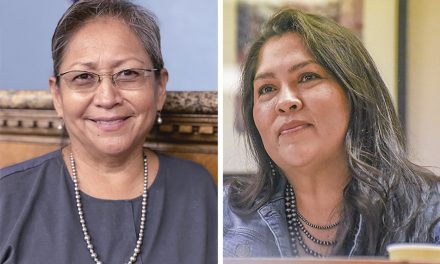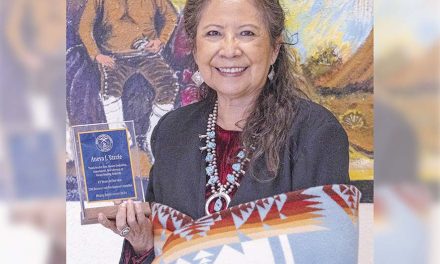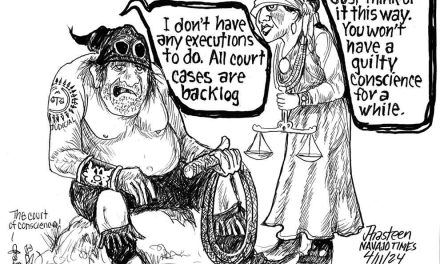
50 Years Ago: Creation of DNA, problem in the schools
If you want to celebrate the golden anniversary of DNA-People’s Legal Services this week, go right ahead.
Because it was on April 25, 1966 that Sargent Shriver, director of the nation’s war on poverty, announced that the federal government decided to provide funds to create a legal aid service on the Navajo Reservation.
Shriver said such an organization was desperately needed on the reservation to protect the interests of 96,000 indigent Navajos living in New Mexico, Arizona and Utah.
First-year funding was to come from an $872,851 grant, which averaged out to less than $10 per indigent Navajo, but it was a start, The program, of course, wasn’t called DNA at the time — that would come later — but the announcement would start officials within the Office of Navajo Economic Opportunity working on getting the program up and running as soon as possible.
The grant called for the new legal aid organization to set up five offices — in Window Rock, Chinle, Tuba City, Shiprock and Crownpoint.
The grant would provide funds to hire two teams in each office which would include an attorney, a Navajo counselor, an investigator and legal staff — secretaries, maintenance workers, etc.
Part of the funds were also set aside for a program to educate Navajos about their legal rights.
It would eventually be called Dinebelina Nahiilna be Agaditahe and its early history was ripe with controversy as the leadership of DNA would go further than anyone expected by not only representing the interests of individual Navajos but also helping masses of people on the reservation by filing class action suits to try to change the way businesses in the border communities treated Navajo customers.
DNA attorneys would even file suit against the Navajo Nation — something that the chairman of the tribe, Raymond Nakai, feared would happen. A class action suit filed by DNA some 30 years ago requiring the tribe not to overpopulate the jails and provide decent conditions, is still in effect today.
The organization had the support of Democrats but made enemies of the Republican leaders of Congress who began getting complaints in the late 60s and early 70s that DNA attorneys were straying too far from their original intent.
By the time Richard Nixon became president of the United States in 1968, Republican leaders in Congress from Arizona began a major effort to cut the organization’s power and for a time there, it looked as if funding would dry up.
Then, according to stories in the Navajo Times in the 1970s, a deal was made with the Republican leadership to save the funding.
The first thing that had to go ws the organization’s name.
For some reason, Republican leadership couldn’t stand the organization being called Dinebelina Nahiilna be Agaditahe. This whole feeling didn’t make a lot of sense back in the 70s and it makes no sense today but one part of the funding agreement was to do away with that name.
The organization was better known in the papers as DNA anyway so the leadership at the time said it would only be referred to as DNA and the words it stood for would no longer be used.
For the sake of clarification, DNA officials added the phase “People’s Legal Services” after the DNA because, in their words, that’s what Dinebelina Nahiilna be Agaditahe, loosely translated, means.
There were other requirements dealing with class action suits that DNA officials had to agree to but the important thing was that the program would continue to be fundied.
This was also the week that, for the first time, the Navajo Times would report that there were problems within the Window Rock Public School District.
Over the years, the paper would report on numerous shake-ups in the administration of the school district but in 1966 this was virgin territory.
The problem was that the paper still was printing mostly press releases and only basically had two writers who were also responsible for layout and editing as well as the running of the paper.
Several teachers within the school district filed a lawsuit against the district after district officials told them that their teaching contracts would not be renewed the following year.
Barney Nobles, one of the teachers, would have his hearing in Apache County Superior Court this week, and the Times published what it could about the dispute, given its limited reporting ability.
The dispute centered on the fact, according to Nobles, that he was not given a reason for the action by the district’s superintendent, William S. Martin.
Nobles pointed out that he had tenure and therefore could only be terminated for cause and by not renewing his contract, for all intents and purposes, the district was firing him.
What he wanted was $20,000, part of which would be used to pay his attorney, and make up for the damage in his reputation. He also wanted a court order requiring the school district rehire him for the upcoming school year.
His case went to a hearing before Superior Court Judge J. Smith Gibbons that week. Nobles immediately dismissed the damage portion of the suit based on the school’s immunity to suits of that nature.
However, the question of Noble’s firing was another matter so he gave each side 15 days to write briefs on this issue and a new hearing was scheduled for early May.
The suit gained some notice in other papers in Arizona because other school districts were watching to see what happened. If the school district was successful, tenured teachers in the other school districts were worried that their school districts would use the same reasoning to fire them, so a lot was at stake.
To read the full article, pick up your copy of the Navajo Times at your nearest newsstand Thursday mornings!
Are you a digital subscriber? Read the most recent three weeks of stories by logging in to your online account.







 Highway 264,
Highway 264, I-40, WB @ Winslow
I-40, WB @ Winslow